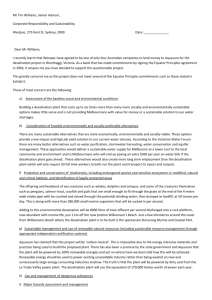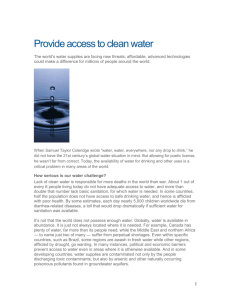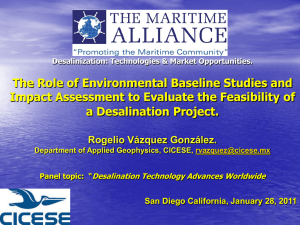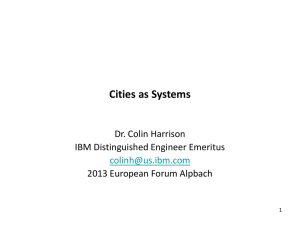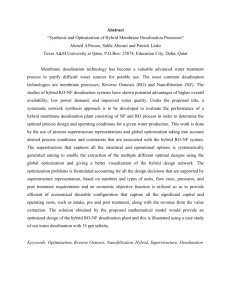Is desalination suitable to sustain life after a tsunami?
advertisement
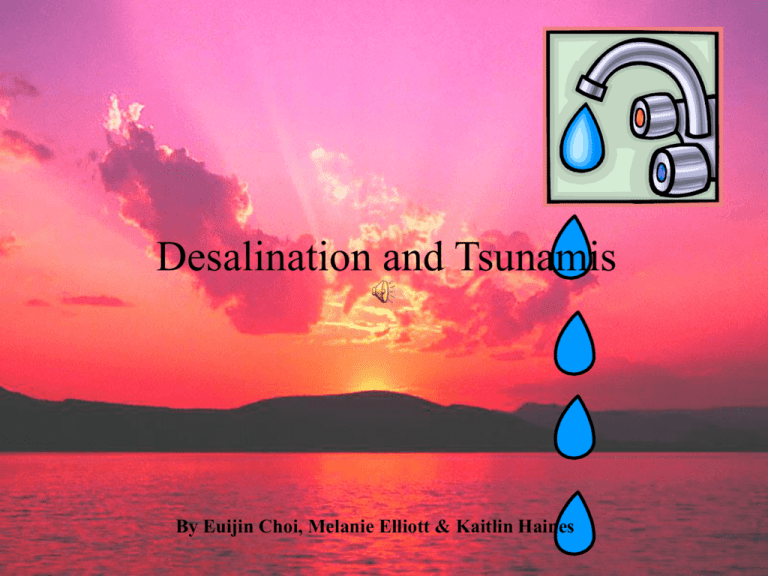
Desalination and Tsunamis By Euijin Choi, Melanie Elliott & Kaitlin Haines Is desalination suitable to sustain life after a tsunami? Yes, it is. In fact, apart from the destruction it leaves behind, Tsunamis are perfect for desalination. This is because the Tsunami leaves behind tonnes of sea water – the main component of desalination. It would be quite simple to extract the salt and turn it into fresh water. When the salty water from the ground has been collected it can be transported to a desalination plant and turned into clean, fresh water which can be used to give access to clean water for many people and animals. Is desalination suitable to sustain life after a tsunami? (continued) When the salt water has been removed from the ground, life can go back to normal. The only downside to desalination is that there is a large amount of energy - 600 kilowatts - needed to make one litre of water, which is not very sustainable or energy efficient. If you were to use the sun in desalination, it would supply roughly half a kilowatt of energy per square metre, which is a small contribution, but worthwhile. What are tsunamis? Tsunamis are ocean waves caused by large earthquakes, volcanoes and landslides that occur near or under the ocean. Tsunami waves are unlike typical ocean waves generated by wind and storms. When tsunamis approach shore they behave like a very fast moving tide that extends far inland. When they hit land, tsunami cause massive destruction and can hit speeds of up to 200 kilometres an hour! Most tsunamis do not break like the curling, windgenerated waves popular with surfers, and they can continue for hours!. Tsunami Survival Kit Being prepared!!! • Pack plenty of water •First Aid Kit •Food (cans of baked beans etc) •Can opener •Torch / batteries •matches •Blankets/warm clothes What is “Desalination”? Desalination is the process of removing salts from seawater to render it suitable for drinking. Water is desalinated in order to be converted to fresh water for human consumption or to supply land with water. It goes through large plants and is heated so the water evaporates and the water and salts are separated. The water is then cooled and transported to towns/cities. There are several ways to do it, however, all the methods are very expensive. If you used a vacuum, you would also save energy and heat, because it would lower the boiling point - which would help to be sustainable in the long run! Afterwards, the excess salt is either turned into salt and salt products or returned to the sea. The desalination process Is it possible to desalinate sea water sustainably? Yes it is, in a way, but not truly. The only way to make desalination more sustainable is to simplify the method and turn it into evaporation or something similar. But you could also replace the heat with natural solar heat, from the sun. Unfortunately the desalination process relies on heat and so you can’t truly sustainably desalinate; only simplify and make easier! You could use natural wave energy to create energy that would heat the water, but even then, it still takes a lot of energy and is not real sustainability. Our Proposal A desalination plant that is near a source of energy (the sun), which is energy and water efficient (as much as possible). •It will gather water from the sea and then transport it in a system of pipes (with a little bit of heat trapped inside) to a building that gets a majority of sun during the day. •The water will then be heated by the sun – in a room that has windows for walls and is facing the sun. • The remaining salt will be collected in bags by workers to be used elsewhere. •The water will then be cooled from water vapour back to liquid in the “freezing room” The Proposal (continued) • The freezing room will be a room with no windows; facing away from the sun. • The water will collect in tubes on the ground and will then be transported to houses around the district. • When the water has been used it will then go back to the plant and to a special room where the water will be filtered clean. • It will then be recirculated around the district again and again, using and gathering no new water since the start. But if need be there could be more water transported to fit needs. There will be no desalination during the night as there would be no sun! Bibliography • http://en.wikipedia.org/wiki/Desalination •http://www.kidzone.ws/WATER •http://www.fema.gov/kids/tsunami.htm •http://www.edwardsaquifer.net/desalination.html •World Book 2009 •Teachers :] •YouTube presentations




